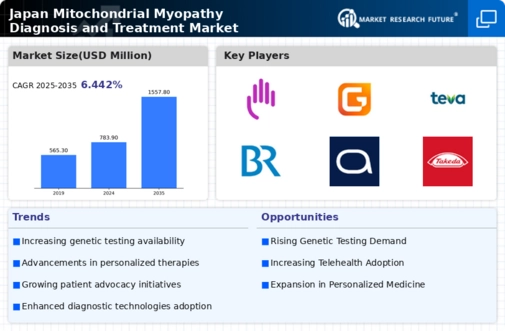Advancements in Genetic Testing
Technological advancements in genetic testing are significantly influencing the mitochondrial myopathy-diagnosis-treatment market. Innovations in next-generation sequencing (NGS) have made it possible to identify genetic mutations associated with mitochondrial disorders more accurately and efficiently. In Japan, the adoption of these advanced diagnostic tools is increasing, with a reported growth rate of 15% in genetic testing services over the past few years. This surge in genetic testing not only aids in early diagnosis but also facilitates personalized treatment approaches, which are becoming increasingly important in managing mitochondrial myopathy. As healthcare providers integrate these technologies into their practices, the market is likely to witness substantial growth.
Supportive Regulatory Environment
The supportive regulatory environment in Japan is a key driver for the mitochondrial myopathy-diagnosis-treatment market. The Japanese government has implemented policies that facilitate the approval and commercialization of orphan drugs, which are essential for treating rare diseases like mitochondrial myopathy. Recent regulatory reforms have streamlined the approval process, reducing the time it takes for new treatments to reach the market. This proactive approach encourages pharmaceutical companies to invest in the development of innovative therapies, thereby expanding the treatment options available for patients. As a result, the market is likely to experience growth as more effective treatments become accessible.
Rising Investment in Rare Disease Research
The growing investment in research and development for rare diseases, including mitochondrial myopathy, is a significant driver for the market. In Japan, government initiatives and private sector funding have increased, with an estimated $200 million allocated to research on rare genetic disorders in the last fiscal year. This financial support is crucial for developing new diagnostic tools and treatment options, which are essential for addressing the unmet needs of patients with mitochondrial myopathy. As research progresses, the mitochondrial myopathy-diagnosis-treatment market is expected to benefit from the introduction of innovative therapies and improved diagnostic methodologies.
Enhanced Awareness and Education Initiatives
Enhanced awareness and education initiatives regarding mitochondrial disorders are playing a pivotal role in the mitochondrial myopathy-diagnosis-treatment market. Various organizations and healthcare institutions in Japan are actively promoting awareness campaigns aimed at educating both healthcare professionals and the public about the symptoms and implications of mitochondrial myopathy. This increased awareness is likely to lead to earlier diagnosis and treatment, thereby improving patient outcomes. Furthermore, educational programs are fostering collaboration among researchers, clinicians, and patients, which may accelerate the development of new therapies and diagnostic tools, ultimately driving market growth.
Increasing Prevalence of Mitochondrial Disorders
The rising incidence of mitochondrial disorders in Japan is a crucial driver for the mitochondrial myopathy-diagnosis-treatment market. Recent studies indicate that mitochondrial myopathy affects approximately 1 in 5,000 individuals, leading to a growing demand for effective diagnostic and therapeutic solutions. As awareness of these conditions increases among healthcare professionals and the general public, more patients are likely to seek diagnosis and treatment. This trend is further supported by the aging population in Japan, which is more susceptible to such disorders. Consequently, the market is expected to expand as healthcare providers enhance their capabilities to diagnose and manage mitochondrial myopathy, thereby improving patient outcomes.
























Leave a Comment